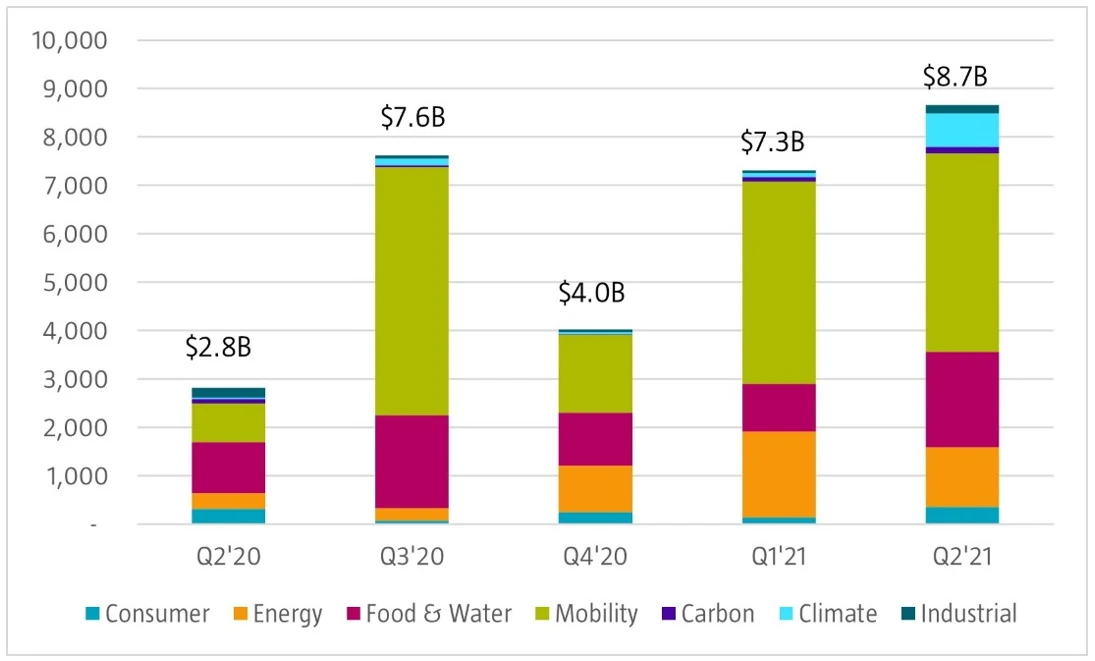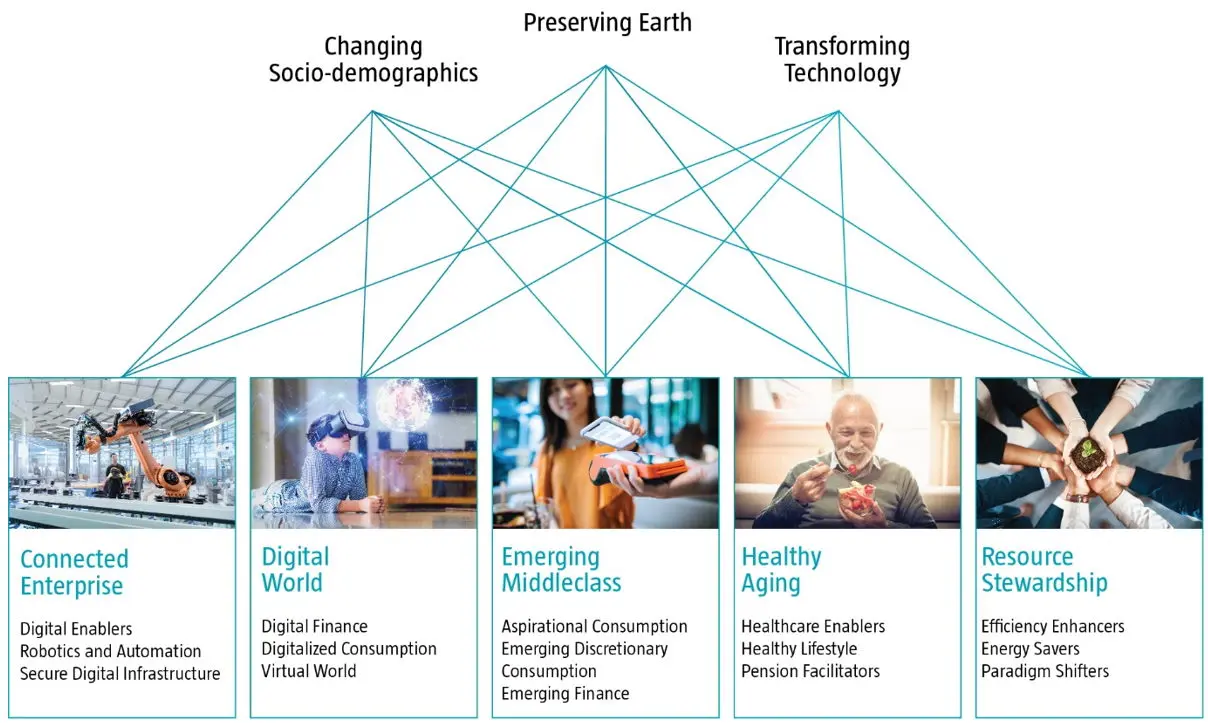With a greater sense of urgency than ever before, and in anticipation of the COP 26 in Glasgow the following year, the WEF gathering called for greener, smarter, and fairer economic growth. Governments around the world responded favorably and we are now seeing large-scale government-led initiatives, such as ‘Build Back Better’ in the United States (US) and the ‘Green Deal’ in the European Union (EU), addressing many of the issues brought forward by ‘The Great Reset’ and its predecessors.
While these political initiatives differ in detail, common elements are increased efforts to decarbonize economic activity and to ground our society and economy on more sustainable principles. The decarbonization efforts focus on electrification of transport, smarter use of energy and power generation from renewable sources, such as wind and solar. The reduction of waste and smarter use of natural and human resources also form the core of the drive to transition to more sustainable economic growth.
“
The pressure to change has clearly grown, with governments and businesses around the world committing to invest staggering amounts to climate transition initiatives
Ambitions backed up by financial commitments
The pressure to change has clearly grown, with governments and businesses around the world committing to invest staggering amounts to climate transition initiatives. In the EU, the Green Deal investment plan aims to mobilize at least EUR 1 trillion in sustainable investments over the next decade. As part of the American Jobs Plan (one of the three parts of the Build Back Better agenda), the Biden Administration is allocating USD 174 billion to incentivize the adoption of electric vehicles, USD 100 billon to fund the transition to carbon-free electricity generation by 2035, and USD 180 billon on research and development, including substantial expenditures in clean energy and basic climate research.
What is more, China and the US reached an agreement at the COP 26, in Glasgow, to cooperate on measures to limit climate change, including lowering methane emissions, phasing out the use of coal, as well as forest conservation. India, meanwhile, promised to generate half of its energy from renewable sources by 2030. More than 450 banks, insurers, pension funds and other firms that manage USD 130 trillion,1 committed to use their funds to reach net zero emissions by 2050. While the exact amounts of investment may change due to negotiations and budgetary pressures, political ambitions are clearly backed up by firm financial commitments.
Figure 1: EU Green Deal Investment Plan

Source: European Commission
“
The large sums invested by governments and the private sector alike act as a magnet for both companies and investors
Investment opportunities abound, but no easy pickings
The multi-faceted investment plans targeting the transition towards a more sustainable economy provide ample investment opportunities. The large sums invested by governments and the private sector alike act as a magnet for both companies and investors. Sectors and industries that are expected to benefit from sustainable investments have already experienced a surge in startup activity and the entry of established players from other industries.
Flows towards sustainable investment funds have also grown rapidly, and are expected to continue to grow. However, this implies that easy pickings from an investor’s perspective are unlikely. Valuations have been driven up, while intense competition might drive down aggregate corporate returns on invested capital. Our contention is that only by investing in companies that provide smarter, greener, and economically viable solutions to environmental, social, and economic challenges, can investors expect to share in the long-term economic success of sustainable winners, while contributing to a better world.
Figure 2: Climate technology venture funding by segment

Source: Climate Tech VC, August 2021
Introducing Resource Stewardship as a fifth trend to MegaTrends
Currently, the Robeco MegaTrends/Rolinco capability invests in four broad trends: ‘Connected Enterprise’, ‘Digital World’, ‘Emerging Middleclass’ and ‘Healthy Aging’. As part of our Connected Enterprise trend, we have invested in several companies that have large exposures to the electrification of transport, smart use of energy and efficient use of natural resources.
Supported by the ambitious government and corporate sustainability pledges, technological innovation, and the likely emergence of long-term winners, we believe this area deserves more research attention. We therefore introduce a fifth sustainability-focused trend in our investment process: ‘Resource Stewardship’.
Doing more with less
Resource Stewardship focuses on companies that help us do more with less. This encompasses companies that enable smarter use of energy, better utilization of human and physical resources, as well as completely new and less ecologically invasive ways of doing things. We distinguish three sub-trends:
Efficiency Enhancers
Energy Savers
Paradigm Shifters
Efficiency Enhancers and Energy Savers aim to benefit from the continuous, incremental innovations that enable us to do things smarter and more efficiently. While perhaps not spectacular, the compounded effect of small but steady improvements over long periods of time can be very significant. Most companies in these two sub-trends are well-established, stable businesses with strong, defensible market positions and attractive returns on invested capital.
Within the Paradigm Shifters sub-trend, we aim to identify companies that, through the application of radical new technologies and/or innovative disruptive business models, have the potential to shake up the status quo, and trigger a paradigm shift. Companies in this sub-trend tend to be at an earlier stage in their development, and may not be profitable yet. They are therefore typically much riskier.
最新のインサイトを受け取る
投資に関する最新情報や専門家の分析を盛り込んだニュースレター(英文)を定期的にお届けします。
Towards a more balanced representation of megatrends
As described in the Big Book of Trends and Thematic Investing, Robeco’s Thematic Investing team distinguishes three megatrend categories that will shape the future: ‘Transforming Technology’, ‘Changing Socio-Demographics’, and ‘Preserving the Earth’. They derive from the technological, demographic, and policy-driven changes that have been shaping society since the dawn of human history. Within these broad categories, the different thematic investment teams select more narrowly defined investment trends that can be broken down into ever more granular trends and sub-trends.
With the addition of Resource Stewardship to the existing four trends in the MegaTrends/Rolinco capability, we think there is now a more balanced representation of the three megatrends categories. At the same time, we are excited by the enhanced investment possibilities that Resource Stewardship offers.
Figure 3: Robeco MegaTrends/Rolinco capability trend overview

Source: Robeco Trends Investing
重要事項
当資料は情報提供を目的として、Robeco Institutional Asset Management B.V.が作成した英文資料、もしくはその英文資料をロベコ・ジャパン株式会社が翻訳したものです。資料中の個別の金融商品の売買の勧誘や推奨等を目的とするものではありません。記載された情報は十分信頼できるものであると考えておりますが、その正確性、完全性を保証するものではありません。意見や見通しはあくまで作成日における弊社の判断に基づくものであり、今後予告なしに変更されることがあります。運用状況、市場動向、意見等は、過去の一時点あるいは過去の一定期間についてのものであり、過去の実績は将来の運用成果を保証または示唆するものではありません。また、記載された投資方針・戦略等は全ての投資家の皆様に適合するとは限りません。当資料は法律、税務、会計面での助言の提供を意図するものではありません。 ご契約に際しては、必要に応じ専門家にご相談の上、最終的なご判断はお客様ご自身でなさるようお願い致します。 運用を行う資産の評価額は、組入有価証券等の価格、金融市場の相場や金利等の変動、及び組入有価証券の発行体の財務状況による信用力等の影響を受けて変動します。また、外貨建資産に投資する場合は為替変動の影響も受けます。運用によって生じた損益は、全て投資家の皆様に帰属します。したがって投資元本や一定の運用成果が保証されているものではなく、投資元本を上回る損失を被ることがあります。弊社が行う金融商品取引業に係る手数料または報酬は、締結される契約の種類や契約資産額により異なるため、当資料において記載せず別途ご提示させて頂く場合があります。具体的な手数料または報酬の金額・計算方法につきましては弊社担当者へお問合せください。 当資料及び記載されている情報、商品に関する権利は弊社に帰属します。したがって、弊社の書面による同意なくしてその全部もしくは一部を複製またはその他の方法で配布することはご遠慮ください。 商号等: ロベコ・ジャパン株式会社 金融商品取引業者 関東財務局長(金商)第2780号 加入協会: 一般社団法人 日本投資顧問業協会


